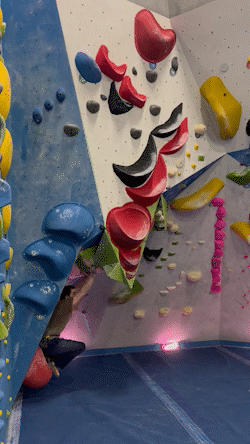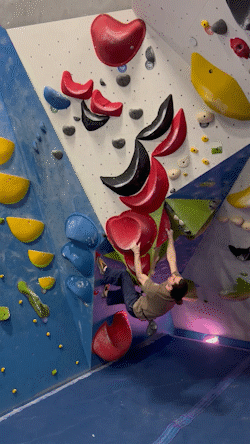Breakdown
Climber: Eddie Pandolfino 6’0”/-2
Wall Angle: Roof > Flat
Holds: Flathold Superstar, Flathold Tokyo 2020, Cheeta Taji Bubble, MW Volumes
RIC: Risk 2, Intensity 3, Complexity 4
The focus of this boulder was to get multiple uses out of the high-profile volume feature. This translates into multiple techniques being used to navigate around it. Risk is present because there are some insecure and committing foot and hand placements. However, it is easy to mitigate these once the beta is decyphered. Intensity is moderate because the boulder has physical qualities. There is pressing and compression, which puts emphasis on shoulder and bicep strength respectively. Complexity is high because there are numerous paths through the sequence and beta can change drastically based on the size of the climber. Finding a sequence that works and sticking with it can be difficult due to all of the options feeling similar in difficulty and the holds having wide surface areas.
Influence/Aesthetic:
When creating a wall-defining feature, it is desirable to have a line that utilizes the feature in its entirety. Although there are other boulders that climb through these volumes, this boulder was designated to use all angles and sides to provide a well-rounded experience. When I started setting the boulder, the only idea I had was to start the climber in a pressed position. After exploring this option, the rest of the line became more obvious and had a distinct flow. All of the holds and volumes touching around and on top of the feature create an obvious conglomerate that is hard to deconstruct. The path can be seen but the nuances are to be found on the journey.
Hold Selection:
The defining feature of most of the holds on this boulder is their profile. Placing the climber farther away from the wall opens their hips and shoulders which makes for less restrictive movement. Many of the holds accentuate wall angles, which helps to keep the body flowing in a comfortable position. To contrast this, there are parts where the holds emphasize the wall angles so much that it creates unfamiliarity because the body is so far removed from the wall that certain techniques like smearing become impossible. However, this opens the opportunity to utilize skills that are used infrequently, like pushing.
Out of the Dark
The climber begins by assuming a seat on the large feature on the sidewall before pressing into the volume. This allows the correct angle to be found before moving.
Creating pressure adds opposition and the climber can begin straightening their legs and adjusting their arms to move rightward while maintaining continued pressure.
Once reaching the small triangle with their right hand, the climber has a grabbable surface. This releases weight from the left hand which opens the chest and hips to pivot.
Squeeze for Ease
The second sequence of moves contrasts the initial pressing with compression.
The climber uses their right hand around the side of the volume to create a point of tension between the sloping holds over the lip.
This secure position helps to keep the chest and shoulders engaged to easily maneuver the feet and hands upward.
The right hand must come over the lip to continue forward, which results in a slightly dynamic swing because of shifting the right shoulder and hip from underneath the roof.
Taking the Top
The large fiberglass feature on the volume helps to drop the length of the flat face lower while extending the profile of the wall.
This creates a positive point for the climber to pivot their hips over and comfortably sink low moving towards the slopers. Flipping the right hand to press aids in this transition.
A high right foot allows the climber to gain the finish hold. Shifting the hips slightly rightward lets the climber gain better traction on the finish hold for the match.
Final Thoughts
This boulder was a pleasant surprise because this was not the original intent for the volumes. We usually add volumes to the zone as a team before we begin setting. As the volumes were being placed, two of my team members (Ayman and Joey) noticed that the triangle volumes could stack and be capped without any gaps. Implementing and expanding upon the team’s ideas is a great way to build a positive rapport. Everyone brings a unique perspective that can be learned from. Workshopping and progressing the team’s concepts is an integral part of keeping the job fresh and maintaining variety in the boulders.



